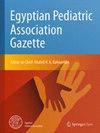儿科不明原因发热:一个中心的病因和临床特点
IF 0.5
Q4 PEDIATRICS
引用次数: 0
摘要
不明原因发热(FUO)是全球儿童的常见病,但仍是诊断难题。不明原因发热的病因因患者的年龄、居住地和研究时间而异。因此,本研究旨在根据目前的诊断能力和新出现的疾病,确定亚历山大大学儿童医院常见的 FUO 病因。本前瞻性观察研究纳入了亚历山大大学儿童医院在 2020 年 1 月至 2021 年 12 月期间收治的所有符合 FUO 定义的儿童,采用步骤法进行调查。本研究共纳入 110 名不明原因发热(FUO)患儿;平均发热持续时间为 36.76 ± 31.73 天。在大多数入选病例中,有 105/110 例(95.4%)确定了 FUO 的明确病因。常见病因包括胶原血管疾病(30.9%)、感染性疾病(28.2%)、其他疾病(19.1%)和恶性肿瘤(17.3%)。在胶原血管疾病中,系统性红斑狼疮(SLE)(47.1%)和系统性幼年特发性关节炎(sJIA)(38.2%)最为常见。在感染类疾病中,片山热(16.1%)、布鲁氏菌病(12.9%)和尿路感染(12.9%)最为常见。杂项中最常见的是后科维德MIS-C(52.4%)。感染类患儿的中性粒细胞[5.76(2.28-7.92)×10^3/µl]和淋巴细胞计数[4.2(2.04-5.91)×10^3/µl]明显较高;(P分别<0.001和<0.010)。此外,在胶原蛋白类别中,淋巴细胞计数中位数较低[1.95(1.47-2.73)×10^3/µl],中性粒细胞/淋巴细胞比率显著较高[2.30(1.53-3.91)](P < 0.010)。胶原血管疾病、传染病、其他疾病和恶性肿瘤是导致 FUO 的最常见原因。片山热、尿路感染(UTI)和布鲁氏菌病是感染性疾病中最常见的病因。科维德后MIS-C和嗜血细胞淋巴组织细胞增多症是杂项类别中最常见的诊断。本文章由计算机程序翻译,如有差异,请以英文原文为准。
Fever of unknown origin in pediatrics: causes and clinical characteristics in a single centre experience
Fever of unknown origin (FUO) is a common condition worldwide in children that remains a diagnostic challenge. The causes of FUO vary depending on the patient's age, residency, and the time of study. Therefore, this study aimed to identify the common aetiologies of FUO at Alexandria University Children’s Hospital under the current diagnostic abilities and newly emerging diseases. The current prospective observational study included all children fulfilling the definition of FUO admitted at Alexandria University Children's Hospital from January 2020 to December 2021 using a steps approach for investigations. A total of 110 children with fever of unknown origin (FUO) were included in this study; the average duration of fever was 36.76 ± 31.73 days. In most of the enrolled cases 105/110 (95.4%) the definite etiology of FUO was identified. The common causes were collagen vascular diseases (30.9%), infectious diseases (28.2%), miscellaneous conditions (19.1%), and malignancy (17.3%). Among collagen vascular diseases, systemic lupus erythematosus (SLE) (47.1%) and systemic onset juvenile idiopathic arthritis (sJIA) (38.2%) were the most common. In the infectious category, Katayama fever (16.1%), brucellosis (12.9%), and urinary tract infection (UTI) (12.9%) were the most frequently observed. Post-Covid MIS-C (52.4%) was the most common in the miscellaneous category. Children in the infectious category had significantly higher neutrophil [5.76 (2.28–7.92) × 10^3/µl] and lymphocytic counts [ 4.2 (2.04–5.91) × 10^3/µl]; (P < 0.001 and < 0.010 respectively). Moreover, in the collagen category the median lymphocytic count was lower [1.95 (1.47–2.73) × 10^3/µl] with a significantly (P < 0.010) higher neutrophil/ lymphocyte ratio [2.30 (1.53–3.91)]. Collagen vascular diseases, infectious diseases, miscellaneous, and malignancy were the most common causes of FUO. Katayama fever, urinary tract infections (UTI), and brucellosis were the most common causes in the infectious category. Post-Covid MIS-C and hemophagocytic lymphohistiocytosis were the most common diagnoses in the miscellaneous category.
求助全文
通过发布文献求助,成功后即可免费获取论文全文。
去求助
来源期刊

Egyptian Pediatric Association Gazette
PEDIATRICS-
自引率
0.00%
发文量
32
审稿时长
9 weeks
期刊介绍:
The Gazette is the official journal of the Egyptian Pediatric Association. The main purpose of the Gazette is to provide a place for the publication of high-quality papers documenting recent advances and new developments in both pediatrics and pediatric surgery in clinical and experimental settings. An equally important purpose of the Gazette is to publish local and regional issues related to children and child care. The Gazette welcomes original papers, review articles, case reports and short communications as well as short technical reports. Papers submitted to the Gazette are peer-reviewed by a large review board. The Gazette also offers CME quizzes, credits for which can be claimed from either the EPA website or the EPA headquarters. Fields of interest: all aspects of pediatrics, pediatric surgery, child health and child care. The Gazette complies with the Uniform Requirements for Manuscripts submitted to biomedical journals as recommended by the International Committee of Medical Journal Editors (ICMJE).
 求助内容:
求助内容: 应助结果提醒方式:
应助结果提醒方式:


